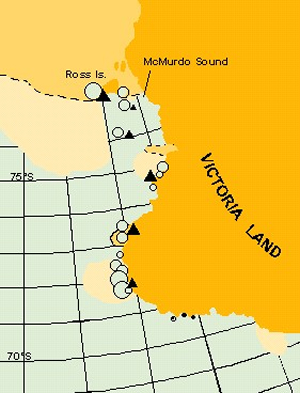Location of penguin colonies
Colonies of Adélie penguins (Pygoscelis adeliae) occur in clusters composed of one large colony (or two medium-sized colonies), surrounded by smaller colonies within the foraging range of the large colony. The locations of the penguin clusters are related to the presence of polynyas or other phenomena (e.g. local upwellings) that facilitate food acquisition.
Polynyas are also important for emperor penguins as access points to breeding areas and food.
 |
 |
| Polynyas marked in yellow | Key |
Polynyas
- These are regions of turbulent, well-mixed, ice-free water created by strong off-shore katabatic winds. Surrounded by pack ice, they teem with phytoplankton in the summer.
- Increasing amounts of sunlight in spring allow Phaeocystis antarctica, a colonial alga, to develop dense blooms of gummy globs of cells. These, however, are not the preferred food of many herbivores.
- On the other hand, single-celled diatoms (algae that are the base of most food chains in this area) grow well around the edges of polynya. Consequently, a dynamic food web is to be found in these regions. For example, stocks of krill are five times more concentrated at the edges of the ice.
- Because Adélies are obligate pack-ice feeders, penguins in some colonies adjacent to polynyas have to swim long distances across open water to reach their feeding grounds. Some years Cape Crozier Adélies have to swim over 100 km!
- Since foraging trip duration is directly related to the distance of pack ice from the colony, trips lasting more than 2 days result in lower adult body masses and less food fed to chicks.
- On the other hand, Adélie colony populations are lower in years when polynya are not well developed, due to a reduction in their prey species.
